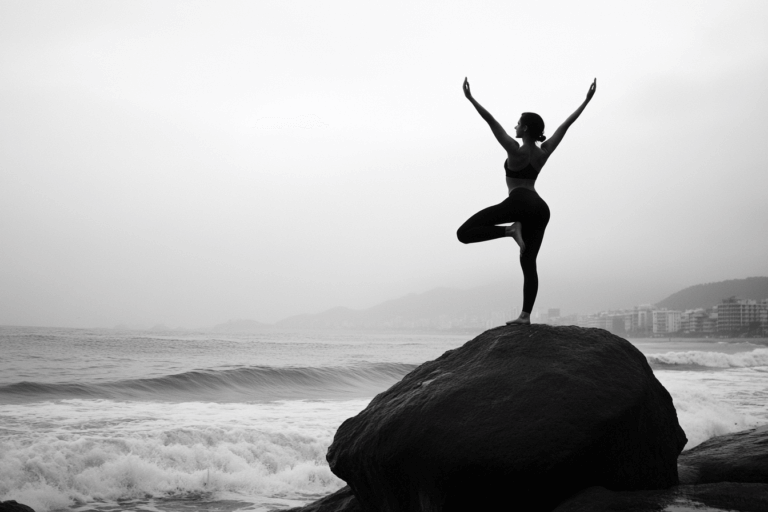I’ve found that moving meditation can be a transformative practice for those of us who struggle with sitting still. It’s a beautiful way to blend mindfulness with physical activity, allowing you to cultivate presence while engaging your body. Whether you’re drawn to walking, yoga, or even gardening, there’s a form of moving meditation that can suit your preferences and lifestyle. As we explore this topic further, you’ll discover how to incorporate this practice into your daily routine, overcome common obstacles, and harness the power of mindful movement to enhance your overall well-being. Are you ready to commence this journey of self-discovery and inner peace?
Moving Meditation: Key Points to Remember

- Choose a movement form that suits you, like walking, tai chi, yoga, or everyday tasks.
- Set aside dedicated time for practice, even if it’s just 10-15 minutes daily.
- Focus on your breath and bodily sensations while moving, maintaining present-moment awareness.
- Gently redirect your attention when your mind wanders during your meditation practice, without judgment or frustration.
- Start with shorter sessions and gradually increase duration as you become more co
Understanding Moving Meditation
Often misunderstood, moving meditation is a powerful practice that combines physical movement with mindfulness.
It’s a versatile technique that allows you to cultivate awareness and presence while engaging in physical activity. Unlike traditional seated meditation, movement meditation exercises can include walking, tai chi, yoga, or even everyday tasks like washing dishes.
To practice moving meditation, start by choosing a type of movement that resonates with you. Focus on your breath and bodily sensations as you move. Notice how your feet connect with the ground, the rhythm of your steps, or the flow of your arms. When your mind wanders, gently bring your attention back to the present moment and your physical experience.
There are various movement meditation techniques you can explore. Walking meditation is a popular choice, where you mindfully walk at a slow pace. Alternatively, you might try mindful stretching or gentle dance movements as part of your movement practices.
The key is to meditate while moving, maintaining a continuous awareness of your body and breath. By incorporating moving meditation into your routine, you’ll develop a deeper connection between your mind and body, enhancing overall well-being and mindfulness in daily life.
Types of Moving Meditation
Moving meditation comes in many forms, each offering a unique way to cultivate mindfulness through movement. As you explore how to practice movement meditation, you’ll discover a variety of techniques that can suit your preferences and lifestyle, including traditional meditation methods.
One popular form is walking meditation, where you focus on each step, feeling the ground beneath your feet and the rhythm of your breath.
Tai Chi and Qigong are ancient Chinese practices that combine slow, flowing movements with breath control and mental focus. Yoga, when practised mindfully, can also be a powerful moving meditation technique.
For those who enjoy more vigorous activity, running meditation allows you to find stillness in motion. Swimming can provide a similar experience, with the added benefit of water’s soothing properties, making it a great type of meditation.
Even everyday activities like gardening or housework can become moving meditation when approached with intention and awareness.
Getting Started
Beginning your moving meditation journey doesn’t have to be complicated; you can start practicing with simple movements. Start by choosing a form of movement that resonates with you, whether it’s walking, yoga, tai chi, or even gardening. The key is to select an activity that you enjoy and can perform regularly.
Next, set aside dedicated time for your meditation practice. It doesn’t have to be long; even 10-15 minutes a day can make a significant difference. Choose a quiet, comfortable space where you won’t be disturbed.
As you begin, focus on your breath and bodily sensations. Notice how your feet connect with the ground, the rhythm of your movements, and the air flowing in and out of your lungs.
As thoughts arise, acknowledge them without judgment and gently return your focus to your movement and breath. Remember, it’s natural for your mind to wander. Be patient with yourself and approach the practice with curiosity and openness.
Consistency is essential, so try to incorporate moving meditation into your daily routine. As you progress, you may find it easier to maintain focus and experience deeper states of mindfulness.
Trust the process and embrace the journey of self-discovery that moving meditation offers.
“Breathing in, I calm body and mind. Breathing out, I smile. Dwelling in the present moment I know this is the only moment”
Thich Nhat Hanh
How to create a Personal Moving Meditation Practice
Developing your own moving meditation ritual can help you establish a consistent practice that resonates with your personal preferences and lifestyle. Here’s how to create a ritual that’s uniquely yours:
Choose Your Movement
Select a form of movement that you enjoy and that feels natural to you. This could be walking, gentle stretching, tai chi, or even mindful gardening. The key is to choose something that you’ll look forward to doing regularly.
Set the Scene
Designate a special place for your practice, whether it’s a quiet corner in your home, a local park, or a peaceful garden. Create an environment that helps you feel calm and centered.
Establish a Routine
Decide on a specific time of day for your practice. Many find that early morning or evening works well. Consistency is key, so choose a time that you can stick to most days.
Create a Starting Ritual
Begin your practice with a simple ritual to signal to your mind that it’s time to enter a meditative state. This could be taking three deep breaths, lighting a candle, or saying a personal mantra.
Incorporate Sensory Elements
Engage your senses to enhance your practice. You might use essential oils, listen to calming music or nature sounds, or hold a smooth stone or beads in your hand as you move.
Set an Intention
Before you begin, set a simple intention for your practice. This could be cultivating peace, fostering gratitude, or simply being present in your body.
Experiment with Duration
Start with short sessions, perhaps 5-10 minutes, and gradually increase the time as you become more comfortable with the practice.
Close Your Practice Mindfully
End your session with a moment of stillness and reflection. Take a few deep breaths and acknowledge the time you’ve dedicated to your well-being.
Journal Your Experience
Keep a brief journal of your practice. Note how you feel before and after, any insights you gained, or challenges you encountered.
Be Flexible and Forgiving
Remember that your ritual can evolve over time. Be open to adjusting your practice as needed, and don’t be too hard on yourself if you miss a day.By creating a personal moving meditation ritual, you’re more likely to maintain a consistent practice that truly serves your needs and enhances your overall well-being. Embrace the process of discovery and allow your ritual to be a reflection of your unique journey towards mindfulness and inner peace.
Incorporating Mindfulness Into Movement
The key to effective moving meditation lies in incorporating mindfulness into your chosen activity. As you engage in your movement, focus on being fully present in each moment. Pay attention to your breath, synchronizing it with your movements when possible. Notice the sensations in your body – the feeling of your feet touching the ground, the air on your skin, or the rhythm of your heartbeat.
I encourage you to observe your thoughts without judgment. If your mind wanders, gently bring your attention back to your movement and breath. Try to cultivate a sense of curiosity about your experience. What do you notice about your body’s movements? How does your energy shift as you continue?
Remember, it’s not about perfection. If you find yourself distracted, that’s okay. Simply acknowledge it and return to your focus. With practice, you’ll find it easier to maintain this mindful state during movement.
As you become more adept, extend your awareness to your surroundings. Notice the sights, sounds, and smells around you, but try not to get caught up in them. Instead, let them flow through your consciousness as you maintain your focus on your movement and breath.
5 Simple Moving Meditation Exercises for Beginners
- Mindful Walking
Begin by walking slowly in a quiet area. Focus on the sensation of your feet touching the ground with each step. Notice the movement of your legs and the rhythm of your breath. When your mind wanders, gently bring your attention back to the physical sensations of walking - Gentle Stretching
Start in a comfortable standing position. Slowly raise your arms overhead while inhaling deeply. As you exhale, lower your arms and fold forward, bending at the hips. Pay attention to the stretch in your muscles and the flow of your breath. Repeat this movement several times, maintaining awareness of your body’s sensations - Body Scan While Moving
Stand with your feet hip-width apart. Starting from your toes, gradually move your attention up through your body, noticing any sensations or tension. As you scan each body part, gently move or rotate it. For example, when focusing on your shoulders, roll them back and forth. This combines awareness with gentle movement - Mindful Arm Movements
Extend your arms out to the sides at shoulder height. Slowly move them in circles, focusing on the sensation in your muscles and joints. Gradually increase the size of the circles, then decrease them. Pay attention to the air moving across your skin as you move - Breath-Synchronized Movement
Stand comfortably and take a few deep breaths. As you inhale, slowly rise up onto your toes and raise your arms overhead. As you exhale, lower your heels and arms. Repeat this movement, synchronizing it with your breath. Focus on the coordination between your breath and movement
Remember, the key to these exercises is maintaining awareness of your body and breath throughout the movement. If your mind wanders, gently bring your focus back to the physical sensations and your breath. Start with just a few minutes and gradually increase the duration as you become more comfortable with the practice
Overcoming Common Challenges
Starting on a moving meditation journey can present some roadblocks, but don’t worry – they’re all surmountable.
One common challenge you might face is difficulty focusing. Your mind may wander, especially when you’re first beginning. Remember, this is normal and part of the process. Gently bring your attention back to your body and breath whenever you notice your thoughts drifting.
Another obstacle you might encounter is finding time in your busy schedule. The key is to start small. Even five minutes of moving meditation can make a difference. Try incorporating it into activities you already do, like walking your dog or climbing stairs.
You may also struggle with self-judgment or frustration if you feel you’re not “doing it right.” Let go of these expectations. There’s no perfect way to practice moving meditation. It’s about the journey, not the destination.
Lastly, physical discomfort or limitations might arise. Listen to your body and adjust your practice accordingly. Remember, moving meditation can be as simple as mindful breathing while seated.
Be patient and kind to yourself as you navigate these challenges.
Moving Meditation FAQs: Answers for Beginners
What are the main benefits of moving meditation compared to seated meditation?
Moving meditation offers several unique benefits compared to seated meditation:
- It’s more accessible for those who struggle with sitting still.
- It combines mindfulness with physical activity, promoting both mental and physical well-being.
- It can be easily incorporated into daily activities like walking or gardening.
- It may be more engaging for some people, making it easier to maintain focus.
- It allows for a deeper connection between mind and body through awareness of physical sensations during movement.
How do I know if I’m doing moving meditation correctly?
You’re likely practicing moving meditation correctly if:
- You’re maintaining present-moment awareness during your chosen activity.
- You’re focusing on your breath and bodily sensations as you move.
- You gently redirect your attention when your mind wanders, without judgment.
- You feel a sense of calm and increased awareness during and after the practice.
- You’re able to maintain a continuous awareness of your body and breath throughout the movement.
Remember, there’s no “perfect” way to practice. The key is consistency and a non-judgmental approach to your experience.
What should I focus on during moving meditation – my breath, body, or surroundings?
In moving meditation, you can focus on all three aspects, but the primary focus is typically on your breath and body. Here’s a suggested approach:
- Start by focusing on your breath, synchronizing it with your movements when possible.
- Pay attention to bodily sensations, such as how your feet connect with the ground or the rhythm of your movements.
- As you become more adept, you can extend your awareness to your surroundings, noticing sights, sounds, and smells.
- However, even when aware of your surroundings, maintain your primary focus on your breath and body sensations.
The key is to remain present and aware, using your breath and body as anchors for your attention.
Conclusion
I hope you’re feeling inspired to begin your moving meditation journey. Remember, it’s all about finding what works for you and embracing the process. Don’t be discouraged if your mind wanders; that’s perfectly normal. With practice, you’ll find yourself more present and aware in your daily life. Trust in your ability to cultivate mindfulness through movement. You’ve got this! Embrace the journey, and enjoy the profound benefits of moving meditation.







